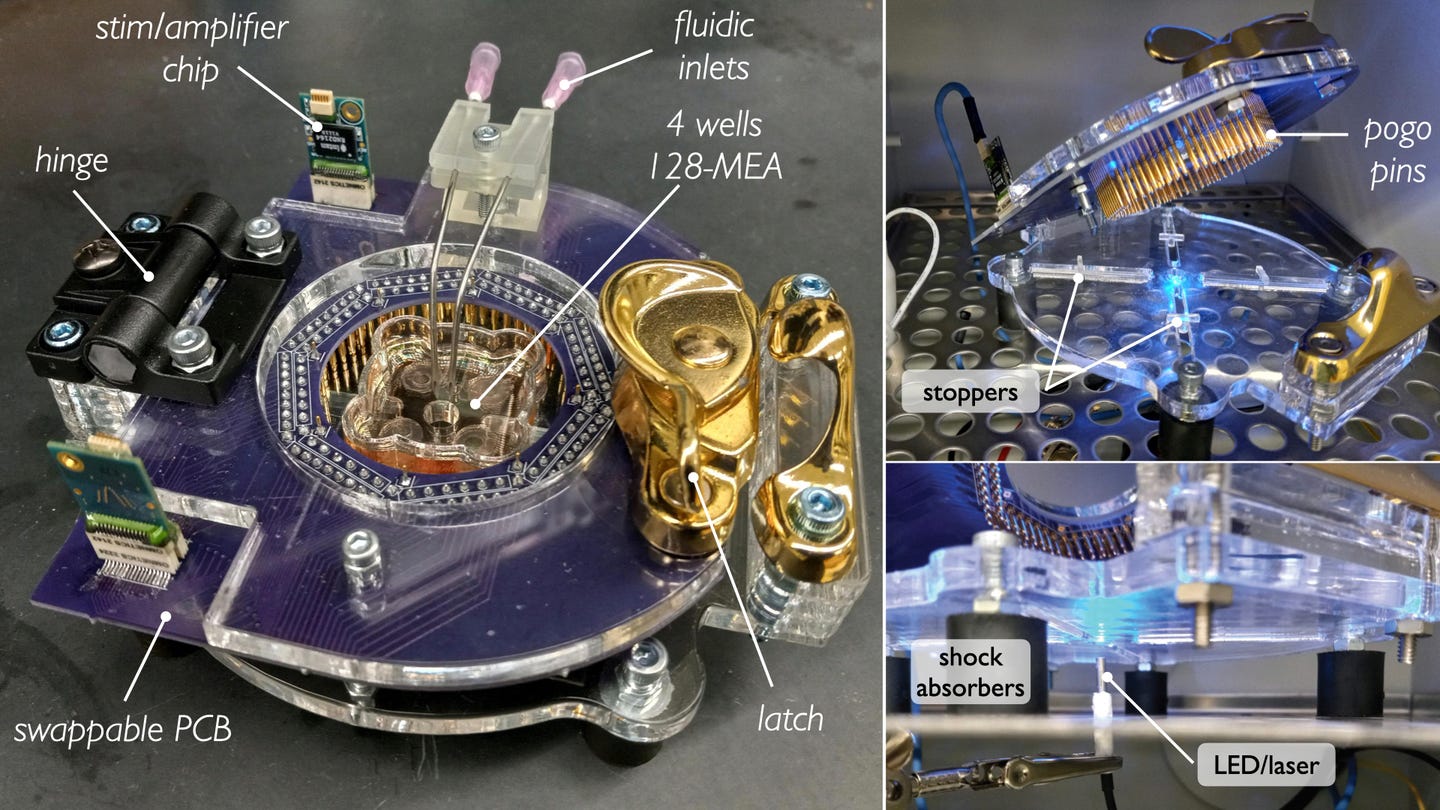Revolutionary open-source technology connects with living neurons
Neurons, the brain’s building blocks, are astonishingly intricate in their communication and response to stimuli.

Hosting MEA-chips and PCB interfaces on-borad, the fully customized recording platform provide a complete signal chain, from the neural substrates to data acquisition terminal and downstream processing. (CREDIT: University of Illinois at Urbana-Champaign)
Neurons, the brain's building blocks, are astonishingly intricate in their communication and response to stimuli. They orchestrate everything from basic bodily functions to complex thoughts. However, traditional neuroscience methods, which rely on in vivo electrophysiology (studying neural activity within a living organism), often struggle to capture the complexity of the brain as a whole.
A groundbreaking alternative approach involves extracting neurons from the organism and conducting studies in a culture dish (in vitro). This method offers researchers enhanced control and precision in measuring neural processes.
In a new study featured in Advanced Science, researchers unveil a cost-effective, open-source in vitro system for interfacing with neurons, providing a more accessible avenue for those intrigued by the intricacies of neural interactions.
The research, part of a larger NSF-funded project called Mind in Vitro (MiV), explores how neurons interact with each other. This project aims to not only gain a deeper understanding of the functions underlying complex systems like the brain but also to eventually harness in vitro neural networks for computational purposes.
Related Stories
To achieve this ambitious goal, the MiV project brings together a highly interdisciplinary group of researchers from fields such as computer science, engineering, neurobiology, physiology, and more.
Zhi (Andrew) Dou, a graduate student in the Gazzola lab and one of the project leaders, explains the overarching goal: "The goal of the MiV project is to ultimately use neurons for computation. This would allow for a system that is dynamic and constantly evolving, unlike traditional computing systems, and is actually more energy-efficient as well."
The MiV study, spearheaded by Mattia Gazzola, an associate professor of mechanical science and engineering, along with Xiaotian Zhang, a postdoctoral researcher in Gazzola's lab, and Dou, introduces an innovative method for measuring neuron activity using micro-electrode array (MEA) technology. While similar commercial systems exist, they are often expensive and tailored to specific experimental approaches.
Graduate student Zhi (Andrew) Dou (left) and postdoctoral researcher Xiaotian Zhang (right). (CREDIT: University of Illinois at Urbana-Champaign)
Zhang points out the limitations of current neuron-interfacing technology: "The problem with the current technology for interfacing with neurons is that it's mainly commercial systems, which are more standardized for specific testing conditions, generally within biochemistry or traditional neuroscience. Since we're interested in engineering computing paradigms out of living cells, our motivation for this was to move away from the more standardized commercial systems and build something ourselves that we would have full control over."
The MiV apparatus places cells onto a plate containing MEAs, allowing it to interface with neural substrates. These electrodes detect voltage changes in neurons, amplifying and sending the data to a computer for processing.
System overview. a) computer-aided design (CAD) illustration of our recording platform, assembled from low-cost materials and commercially available parts. (CREDIT: Advanced Science)
Compared to standard 60-electrode commercial systems, the MiV system boasts over 500 electrodes, enabling the collection of more data simultaneously. Additionally, the MiV system incorporates novel features such as portability, bi-directional communication with neurons, the ability to image neurons during recordings, and the capacity to test multiple types of inputs (electric and optical) and multiple cell populations concurrently.
Despite these enhancements, the cost to build the MiV system is remarkably ten times lower than that of a commercial system, and it is fully customizable. In a generous move, the researchers have made their hardware and software models for the MiV system open source and freely available online.
Comparison among recent custom electrophysiology approaches. (CREDIT: Advanced Science)
Zhang emphasizes the importance of open source accessibility: "Having our software and hardware be open source was really important to us. We wanted to bring the cost down to make this technology available to others and have it be more flexible and versatile so that researchers can really customize their experimental settings for whatever they need. Our system is not for only one lab or one group of people interested in one specific thing; it's for everyone."
Dou adds, "We designed our system to be very easy to make and comprised of inexpensive parts, which will allow a lot of labs that can't afford the commercial system to have their own system. Even though the original design is for computational studies, we've made the structure easy to redesign and expand upon, so we're pretty sure this will satisfy researchers no matter the kind of studies they want to do."
The enthusiasm for this innovative technology extends beyond the MiV team, as other labs express interest in adopting it for their own experiments. The MiV team plans to continue refining the design, making the hardware more automated and accessible, and exploring ways to quantify and improve the technology's performance.
In a world where understanding the brain's complexities remains a formidable challenge, the MiV project's open-source, cost-effective in vitro system offers a promising and accessible tool for researchers to uncover the secrets of neural interactions. With the potential to revolutionize computation and our comprehension of the brain, this innovative approach brings us one step closer to unraveling the mysteries of the human mind.
The study was funded by the NSF, and can be found at https://doi.org/10.1002/advs.202306826.
Links for the open-source hardware designs and software can be found at https://gazzolalab.github.io/MiV-OH/ and https://miv-os.readthedocs.io/ respectively.
Note: Materials provided above by The Brighter Side of News. Content may be edited for style and length.
Like these kind of feel good stories? Get the Brighter Side of News' newsletter.
JJ Shavit
Joshua Shavit
Science & Technology Writer | AI and Robotics Reporter
Joshua Shavit is a Los Angeles-based science and technology writer with a passion for exploring the breakthroughs shaping the future. As a contributor to The Brighter Side of News, he focuses on positive and transformative advancements in AI, technology, physics, engineering, robotics and space science. Joshua is currently working towards a Bachelor of Science in Business Administration at the University of California, Berkeley. He combines his academic background with a talent for storytelling, making complex scientific discoveries engaging and accessible. His work highlights the innovators behind the ideas, bringing readers closer to the people driving progress.



